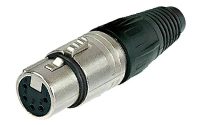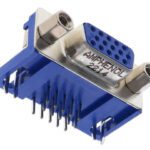What is an XLR Connector?
Meet the Connector: XLR Connector
XLR connectors are a type of electrical connector commonly used in professional audio and video (AV) applications, with limited application in medical video technologies and industrial AV equipment. The name “XLR” stands for “eXternal Line Return.” The XLR is sometimes referred to simply as an audio connector.
This circular connector with a long, cylindrical metal housing was first introduced by the Cannon Electric Company (now ITT Cannon) in the 1950s as the XL Series audio connector. It was invented by James H. Cannon and designed for use in military applications and sound equipment. Since its introduction, the XLR type has become the primary solution for both analog and digital connections for audio devices, including microphones, amplifiers, and mixing consoles. It is also used for stage lighting and live events.

ITT Cannon originated the XLR connector in the 1950s. The company has refined the design over the decades and still offers the product today.
The shell of XLR connectors contain a latch that locks it into place and prevents accidental disconnections. This reliability feature is particularly useful in live events where long cables are used in large installations where risks exist from movement or mechanical stress.
XLR connectors contain three pins responsible for carrying balanced audio signals. This configuration helps minimize interference and noise, resulting in cleaner audio transmission over longer distances.
- Pin 1 is the ground or shield connection, which provides a path for electrical noise to be safely discharged.
- Pin 2 carries the positive or “hot” audio signal.
- Pin 3 carries the negative or “cold” audio signal.
In addition to audio signals, XLR connectors can also carry other types of signals, such as DMX (Digital Multiplex) used in lighting control systems, AES/EBU (Audio Engineering Society/European Broadcasting Union) digital audio signals, and, historically, with some MIDI applications.
Variations XLR connectors come in different sizes, denoted by the number of pins they have. The most common type is the XLR-3, which has three pins as described earlier. However, variations with up to 10 pins are available.
Design notes for XLR Connectors
Standardization XLR connectors meet the IEC 61076-2-103 international standard for dimensions. A mini-XLR connector is available but is not currently standardized.

XLR connectors typically have three pins, but four- and five-pin variations such as this Neutrik NC5FX 5-Pin connector, also exist for specific applications.
Mating style Push-on or snap-on
Mounting Chassis or panel mount
Size Circumference at widest point is 59.7 mm (2.35 in)Caveats The three-pin XLR connector is often used for DMX512 on lighting and control equipment, often by the DJ market. However, using three-pin XLR connectors for DMX512 is specifically prohibited by section 7.1.2 of the DMX512 standard as it risks damaging the lighting equipment in the event of connection with an audio cable carrying 48-volt phantom power.
Cable considerations
When using XLR connectors, it is important to note that they require balanced cables to take full advantage of their noise-rejection capabilities.
Balanced cables have three conductors — a positive, a negative, and a shield — which correspond to the three pins of the XLR connector. These cables help ensure proper signal transmission and reduce the risk of interference.
Claim to fame: In 2008, the XLR connector was inducted into the TECnology Hall of Fame by the Mix Foundation for Excellence in Audio.
Markets, Sectors, and Applications
Industrial, Consumer, Medical, Military and Aerospace
XLR connectors are essential to the entertainment industry and can be found in equipment ranging from a singer’s microphone to stage lighting, amplifiers, synthesizers, television equipment, and elements of stage rigging. XLR-4 and XLR-5 connectors are often used for specific AV applications that require additional connections, such as stereo audio or intercom systems. For example, the four-pin version is used with professional film and video equipment; the fourth pin powers an LED light indicating the power is on.
Five-pin XLR connectors are the standard choice for DMX512 digital lighting control and are also used for aviation headsets and military audio applications.
As video technologies are more frequently employed in medicine, the XLR connector has some use in medical equipment such as electrosurgical units, EMG and EEG equipment, and AV systems used in operating rooms.
Suppliers:
Amphenol (supplied by DigiKey), Globtek, ITT Cannon, Neutrik (supplied by Mouser Electronics), Switchcraft (supplied by TTI Inc.)
Related products:
- XLR cables
- Push-pull connectors
- Circular connectors
- XLD connectors
- DIN connector
- RCA connector
- RF connector
Like this article? Check out our other Meet the Connector, Circular Connectors, and our Medical Market Page, and our 2022 and 2023 Article Archive.
Subscribe to our weekly e-newsletters, follow us on LinkedIn, Twitter, and Facebook, and check out our eBook archives for more applicable, expert-informed connectivity content.
- Where in the World is Amphenol LTW’s Luc Kan? - April 23, 2024
- TE Connectivity’s Sustainability Efforts Pay Off - April 23, 2024
- What is a VGA Connector? - April 23, 2024





